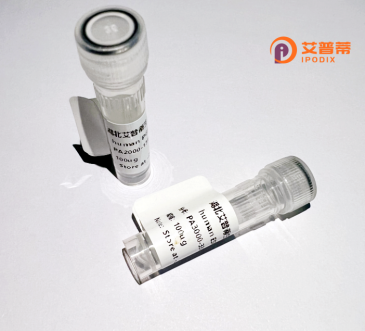
| 纯度 | >90%SDS-PAGE. |
| 种属 | Human |
| 靶点 | CIR |
| Uniprot No | P48544 |
| 内毒素 | < 0.01EU/μg |
| 表达宿主 | E.coli |
| 表达区间 | 1-450aa |
| 氨基酸序列 | MGKSFANFMCKKDFHPASKSNIKKVWMAEQKISYDKKKQEELMQQYLKEQESYDNRLLMGDERVKNGLNFMYEAPPGAKKENKEKEETEGETEYKFEWQKGAPREKYAKDDMNIRDQPFGIQVRNVRCIKCHKWGHVNTDRECPLFGLSGINASSVPTDGSGPSMHPSELIAEMRNSGFALKRNVLGRNLTANDPSQEYVASEGEEDPEVEFLKSLTTKQKQKLLRKLDRLEKKKKKKDRKKKKFQKSRSKHKKHKSSSSSSSSSSSSSSTETSESSSESESNNKEKKIQRKKRKKNKCSGHNNSDSEEKDKSKKRKLHEELSSSHHNREKAKEKPRFLKHESSREDSKWSHSDSDKKSRTHKHSPEKRGSERKEGSSRSHGREERSRRSRSRSPGSYKQRETRKRAQRNPGEEQSRRNDSRSHGTDLYRGEKMYREHPGGTHTKVTQRE |
| 分子量 | 78.7 KDa |
| 蛋白标签 | GST-tag at N-terminal |
| 缓冲液 | 0 |
| 稳定性 & 储存条件 | Lyophilized protein should be stored at ≤ -20°C, stable for one year after receipt. Reconstituted protein solution can be stored at 2-8°C for 2-7 days. Aliquots of reconstituted samples are stable at ≤ -20°C for 3 months. |
| 复溶 | Always centrifuge tubes before opening.Do not mix by vortex or pipetting. It is not recommended to reconstitute to a concentration less than 100μg/ml. Dissolve the lyophilized protein in distilled water. Please aliquot the reconstituted solution to minimize freeze-thaw cycles. |
以下是关于重组人CIR蛋白(假设为 **Cold-Inducible RNA-Binding Protein, CIRP**)的3条示例参考文献,涵盖功能、机制及应用研究方向:
---
1. **文献名称**:*"Recombinant Human CIRP Attenuates Cerebral Ischemia-Reperfusion Injury by Suppressing Apoptosis via the ERK1/2 Pathway"*
**作者**:Chen Y, et al.
**摘要**:该研究在大鼠脑缺血再灌注模型中,证明重组人CIRP通过激活ERK1/2信号通路抑制神经元凋亡,显著减轻脑组织损伤,提示其在神经保护中的潜在治疗价值。
2. **文献名称**:*"Expression and Functional Characterization of Recombinant Human CIRP in Hypothermia-Induced Cellular Adaptation"*
**作者**:Wang L, et al.
**摘要**:作者利用大肠杆菌表达系统成功制备重组人CIRP,并发现低温环境下CIRP通过稳定mRNA提高细胞抗氧化能力,为低温相关疾病的分子机制提供新见解。
3. **文献名称**:*"Pro-inflammatory Role of Extracellular CIRP in Sepsis: Insights from Recombinant Protein Models"*
**作者**:Kimura T, et al.
**摘要**:研究发现,重组人CIRP作为损伤相关分子模式(DAMP)释放至胞外后,通过TLR4/MyD88通路促进巨噬细胞炎症因子分泌,加剧脓毒症病理进程。
---
**备注**:若“CIR”指代其他蛋白(如特定受体或未明确缩写),建议补充背景信息以便提供更精准的文献。实际研究中,可通过PubMed或Google Scholar以关键词“recombinant human CIRP”或“CIR protein function”检索最新文献。
Recombinant human CIR protein (commonly referring to Cold-Inducible RNA-binding protein, CIRP) is a stress-responsive protein involved in cellular adaptation to environmental challenges. Initially identified for its upregulation under hypothermia, CIRP regulates RNA metabolism, including transcription, splicing, translation, and stability, by binding to specific RNA motifs. Structurally, it contains an RNA-binding domain and a arginine-rich motif, enabling interactions with RNA and other proteins. CIRP plays roles in cell cycle regulation, apoptosis suppression, and inflammation modulation. Under stress conditions, it translocates from the nucleus to the cytoplasm, influencing pathways like NF-κB and MAPK.
Recombinant CIRP is produced using expression systems (e.g., *E. coli*, mammalian cells) for functional studies. It aids in elucidating mechanisms in ischemia-reperfusion injury, neurodegenerative diseases, and cancer, where dysregulated CIRP contributes to disease progression. Its dual role as a protective stress adaptor and a pro-inflammatory damage-associated molecular pattern (DAMP) makes it a therapeutic target. Research on recombinant CIRP focuses on neutralizing its harmful extracellular effects while harnessing its intracellular protective functions, offering potential in treating inflammatory and ischemic conditions.
×